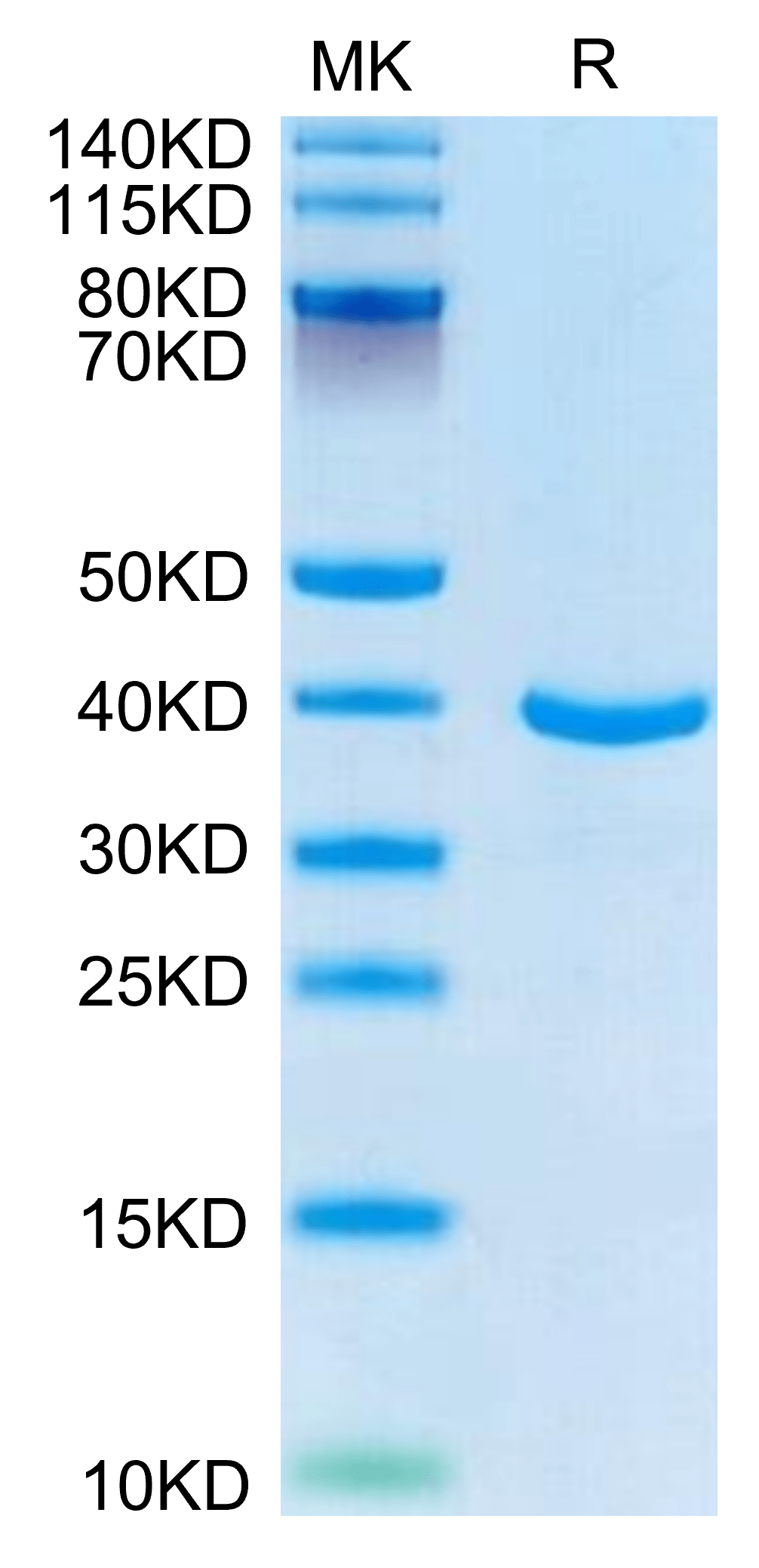| Weight | 1 lbs |
|---|---|
| Dimensions | 9 × 5 × 2 in |
| accession | P04083 |
| express system | E.coli |
| product tag | C-His |
| purity | > 95% as determined by Tris-Bis PAGE |
| background | Atherosclerosis, characterized by the formation of fat-laden plaques, is a chronic inflammatory disease. ABCA1 promotes cholesterol efflux, reduces cellular cholesterol accumulation, and regulates anti-inflammatory activities in an apoA-I- or ANXA1-dependent manner. The latter activity occurs by mediating the efflux of ANXA1, which plays a critical role in anti-inflammatory effects, cholesterol transport, exosome and microparticle secretion, and apoptotic cell clearance. |
| molecular weight | The protein has a predicted MW of 39.5 kDa same as Tris-Bis PAGE result. |
| available size | 100 µg, 500 µg |
| endotoxin | Less than 1EU per μg by the LAL method. |
Human ANXA1 Protein 3766
$240.00 – $800.00
Summary
- Expression: E.coli
- Pure: Yes (SDS-PAGE)
- Amino Acid Range: Met1-Asn346
Human ANXA1 Protein 3766
| protein |
|---|
| Size and concentration 100, 500µg and lyophilized |
| Form Lyophilized |
| Storage Instructions Valid for 12 months from date of receipt when stored at -80°C. Recommend to aliquot the protein into smaller quantities for optimal storage. Please minimize freeze-thaw cycles. |
| Storage buffer Shipped at ambient temperature. |
| Purity > 95% as determined by Tris-Bis PAGE |
| target relevance |
|---|
| Atherosclerosis, characterized by the formation of fat-laden plaques, is a chronic inflammatory disease. ABCA1 promotes cholesterol efflux, reduces cellular cholesterol accumulation, and regulates anti-inflammatory activities in an apoA-I- or ANXA1-dependent manner. The latter activity occurs by mediating the efflux of ANXA1, which plays a critical role in anti-inflammatory effects, cholesterol transport, exosome and microparticle secretion, and apoptotic cell clearance. |
| Protein names Annexin A1 (Annexin I) (Annexin-1) (Calpactin II) (Calpactin-2) (Chromobindin-9) (Lipocortin I) (Phospholipase A2 inhibitory protein) (p35) [Cleaved into: Annexin Ac2-26] |
| Gene names ANXA1,ANXA1 ANX1 LPC1 |
| Protein family Annexin family |
| Mass 38714Da |
| Function Plays important roles in the innate immune response as effector of glucocorticoid-mediated responses and regulator of the inflammatory process. Has anti-inflammatory activity (PubMed:8425544). Plays a role in glucocorticoid-mediated down-regulation of the early phase of the inflammatory response (By similarity). Contributes to the adaptive immune response by enhancing signaling cascades that are triggered by T-cell activation, regulates differentiation and proliferation of activated T-cells (PubMed:17008549). Promotes the differentiation of T-cells into Th1 cells and negatively regulates differentiation into Th2 cells (PubMed:17008549). Has no effect on unstimulated T cells (PubMed:17008549). Negatively regulates hormone exocytosis via activation of the formyl peptide receptors and reorganization of the actin cytoskeleton (PubMed:19625660). Has high affinity for Ca(2+) and can bind up to eight Ca(2+) ions (By similarity). Displays Ca(2+)-dependent binding to phospholipid membranes (PubMed:2532504, PubMed:8557678). Plays a role in the formation of phagocytic cups and phagosomes. Plays a role in phagocytosis by mediating the Ca(2+)-dependent interaction between phagosomes and the actin cytoskeleton (By similarity).; [Annexin Ac2-26]: Functions at least in part by activating the formyl peptide receptors and downstream signaling cascades (PubMed:22879591, PubMed:15187149, PubMed:25664854). Promotes chemotaxis of granulocytes and monocytes via activation of the formyl peptide receptors (PubMed:15187149). Promotes rearrangement of the actin cytoskeleton, cell polarization and cell migration (PubMed:15187149). Promotes resolution of inflammation and wound healing (PubMed:25664854). Acts via neutrophil N-formyl peptide receptors to enhance the release of CXCL2 (PubMed:22879591). |
| Subellular location Nucleus. Cytoplasm. Cell projection, cilium. Cell membrane. Membrane ; Peripheral membrane protein. Endosome membrane ; Peripheral membrane protein. Basolateral cell membrane. Apical cell membrane. Lateral cell membrane. Secreted. Secreted, extracellular space. Cell membrane ; Peripheral membrane protein ; Extracellular side. Secreted, extracellular exosome. Cytoplasmic vesicle, secretory vesicle lumen. Cell projection, phagocytic cup. Early endosome. Cytoplasmic vesicle membrane ; Peripheral membrane protein. Note=Secreted, at least in part via exosomes and other secretory vesicles. Detected in exosomes and other extracellular vesicles (PubMed:25664854). Alternatively, the secretion is dependent on protein unfolding and facilitated by the cargo receptor TMED10; it results in the protein translocation from the cytoplasm into ERGIC (endoplasmic reticulum-Golgi intermediate compartment) followed by vesicle entry and secretion (PubMed:32272059). Detected in gelatinase granules in resting neutrophils (PubMed:10772777). Secretion is increased in response to wounding and inflammation (PubMed:25664854). Secretion is increased upon T-cell activation (PubMed:17008549). Neutrophil adhesion to endothelial cells stimulates secretion via gelatinase granules, but foreign particle phagocytosis has no effect (PubMed:10772777). Colocalizes with actin fibers at phagocytic cups (By similarity). Displays calcium-dependent binding to phospholipid membranes (PubMed:2532504, PubMed:8557678). |
| Tissues Detected in resting neutrophils (PubMed:10772777). Detected in peripheral blood T-cells (PubMed:17008549). Detected in extracellular vesicles in blood serum from patients with inflammatory bowel disease, but not in serum from healthy donors (PubMed:25664854). Detected in placenta (at protein level) (PubMed:2532504). Detected in liver. |
| Structure Homodimer; non-covalently linked (By similarity). Homodimer; linked by transglutamylation (PubMed:2532504). Homodimers linked by transglutamylation are observed in placenta, but not in other tissues (PubMed:2532504). Interacts with S100A11 (PubMed:8557678, PubMed:10673436). Heterotetramer, formed by two molecules each of S100A11 and ANXA1 (PubMed:10673436). Interacts with DYSF (By similarity). Interacts with EGFR (By similarity). |
| Post-translational modification Phosphorylated by protein kinase C, EGFR and TRPM7 (PubMed:2457390, PubMed:15485879). Phosphorylated in response to EGF treatment (PubMed:2532504).; Sumoylated.; Proteolytically cleaved by cathepsin CTSG to release the active N-terminal peptide Ac2-26. |
| Target Relevance information above includes information from UniProt accession: P04083 |
| The UniProt Consortium |
Publications
Publications
| pmid | title | authors | citation |
|---|---|---|---|
| We haven't added any publications to our database yet. | |||
Protocols
| relevant to this product |
|---|
Documents
| # | ||
|---|---|---|
| Please enter your product and batch number here to retrieve product datasheet, SDS, and QC information. | ||















